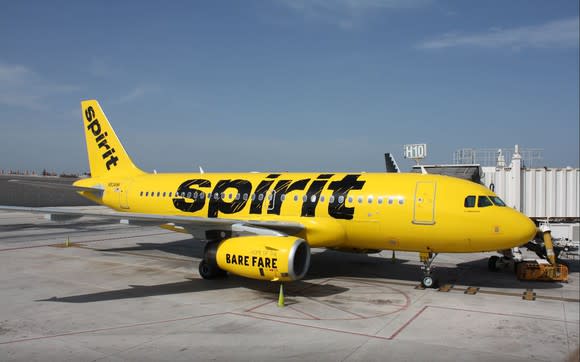Spirit Airlines Plots Its Next CEO Transition
In early 2016, long-serving Spirit Airlines (NASDAQ: SAVE) CEO Ben Baldanza resigned abruptly. He was immediately replaced by Spirit board member (and former AirTran Airways CEO) Robert Fornaro.
However, it was clear from day one that Fornaro would be more of a caretaker -- charged with guiding Spirit Airlines through a bumpy transitional period -- than a long-term replacement. (When he took the helm of Spirit, Fornaro was 63, nearly a decade older than his predecessor.)
On Wednesday, Spirit revealed that Fornaro plans to step down at the end of 2018. Current CFO Ted Christie will take the top job at that time. He will be in charge of plotting a new long-term growth strategy for Spirit Airlines in what has become a tough competitive environment for ultra-low-cost carriers.
2018 will be critical for Fornaro's legacy
Bob Fornaro has led Spirit Airlines through two turbulent years. When he first took the top job, Spirit Airlines was producing record earnings, but its unit revenue was plunging -- threatening to undermine the company's profitability in a hurry.

Falling unit revenue has plagued Spirit Airlines in recent years. Image source: Spirit Airlines.
As CEO, Fornaro has pushed some key strategy changes with the goal of bolstering Spirit's unit revenue performance. First, Spirit Airlines has reoriented its growth from a focus on the largest markets in the U.S. -- many of which are dominated by the legacy carriers -- to midsize markets where Southwest Airlines is often the top carrier today. Second, Fornaro has put a much greater emphasis on friendly service and operational reliability.
Earlier this year, these initiatives seemed to be working. In late April, Spirit Airlines projected that unit revenue would rise by about 5% in Q2. Shortly thereafter, a management-pilot dispute broke out, forcing the carrier to cancel hundreds of flights. This was followed by a renewed fare war with United Continental. These setbacks undid much of Spirit's progress, causing unit revenue to fall 6.3% year over year last quarter.
The tide has started to turn again. Spirit's guidance calls for a 4%-6% unit revenue decline this quarter, but several airlines have raised their unit revenue forecasts in the past few weeks. The company's operational performance has rebounded as well. Over the past two months, Spirit Airlines has completed 99.5% of its scheduled flights, with nearly 90% of them reaching the gate within 14 minutes of their scheduled arrival time.
With Spirit Airlines' operations back on track and further route network diversification in the works, Fornaro's strategy may finally pay off in 2018. But for that to happen, Spirit must avoid being pulled into another fare war. It also needs to finalize a long-term contract with its pilots, who are starting to become restless again. In short, 2018 will be a make-or-break year for Fornaro's legacy as CEO of Spirit Airlines.
Why Christie will be the next CEO
Ted Christie has been Spirit Airlines' CFO for the past five years. As part of his transition to CEO, he will be promoted to president of the company and join its board of directors in January.
Christie was the natural internal candidate to succeed Fornaro. He is just 46 years old, so he could potentially lead the company for a decade or more. Furthermore, his deep familiarity with the cost side of the business will be a key asset. Spirit Airlines will face a big cost headwind upon reaching a deal with its pilots for a new contract. Finding ways to offset those wage increases -- e.g., through higher productivity, better use of Spirit's growing purchasing power, etc. -- will be critical to the company's success in the years ahead.
What comes next?
Spirit Airlines has already indicated that its growth rate will slow somewhat after 2018. In the next year, under the joint leadership of Fornaro and Christie, the company will have to make some more detailed (and extremely important) decisions about its future growth.
Most notably, Spirit Airlines needs to supplement its current aircraft order book. This will entail decisions about its rate of capacity growth, whether or not to renew expiring aircraft leases, the appropriate mix of smaller and larger models within the Airbus A320 family -- which in turn requires estimating the size of the markets Spirit will enter over the next five to 10 years -- and even the possibility of adding a second aircraft type to the fleet.
Spirit made the right decision to give Christie a full seat at the table as these decisions are made. After all, he will have to live with these decisions as Spirit Airlines' CEO in 2019 and beyond.
More From The Motley Fool
6 Years Later, 6 Charts That Show How Far Apple, Inc. Has Come Since Steve Jobs' Passing
Why You're Smart to Buy Shopify Inc. (US) -- Despite Citron's Report
Adam Levine-Weinberg owns shares of Spirit Airlines. The Motley Fool owns shares of and recommends Spirit Airlines. The Motley Fool has a disclosure policy.
